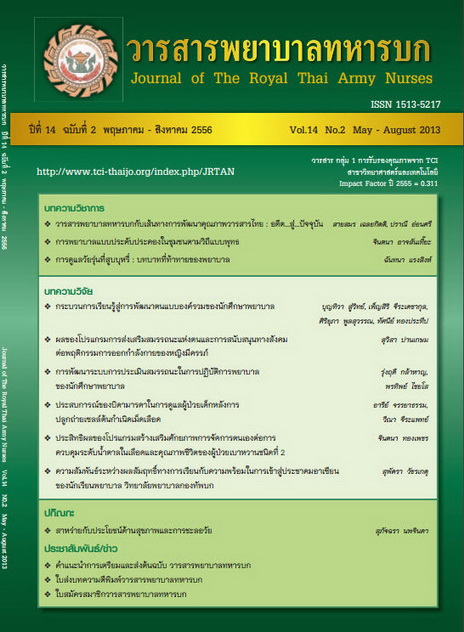การพยาบาลแบบประคับประคองในชุมชนตามแนวคิดแบบพุทธ (Palliative Carein community with the concept of Buddhism )
Keywords:
การพยาบาลแบบประคับประคองในชุมชนแนวพุทธ, เทคนิคอุ่นใจ เข้าใจ ทำใจ และปลงใจ, Palliative care in community, Buddhism traditions, 4 techniques in developing relationships, understanding, mindfulness, acceptanceAbstract
บทคัดย่อ
การพยาบาลแบบประคับประคองในชุมชนมีความสำคัญมากขึ้น หลังจากที่จำนวนผู้เจ็บป่วยด้วยโรคเรื้อรังรักษาไม่หายขาดมีจำนวนมากขึ้นสอดคล้องกับการเพิ่มขึ้นของผู้สูงอายุที่ร่างกายมีความเสื่อมตามวัย บทความนี้มีวัตถุประสงค์เพื่ออธิบายการพยาบาลแบบประคับประคองในชุมชนให้มีคุณภาพชีวิตที่ดี ตามวิถีชาวพุทธโดยพยาบาลสาธารณสุขมีบทบาทในการดูแลและเป็นผู้สนับสนุนให้ผู้ป่วยและครอบครัวมีความมั่นใจในการดูแลและเข้าใจในหลักการของการพยาบาลแบบประคับประคองซึ่งเป็นการดูแลผู้ป่วยด้านร่างกาย เช่นการควบคุมความเจ็บปวด และอาการอื่นๆรวมทั้งการดูแลทาง จิตใจ สังคม และจิตวิญญาณ สำหรับผู้ที่ป่วยด้วยโรคที่คุกคามต่อชีวิต ซึ่งไม่ได้จำกัดอยู่ที่ผู้ป่วยระยะสุดท้ายแต่เป็นการเริ่มดูแลตั้งแต่เริ่มต้น เมื่อได้รับการวินิจฉัยโรคที่รักษาไม่หายขาด ซึ่งเป็นการพยาบาลเชิงรุกที่ให้ผู้ป่วยบรรเทาความทุกข์ทรมานจนถึงวาระสุดท้าย สามารถจัดการภาระกิจที่ค้างคาและจากลาด้วยความสงบ จากหลักการพยาบาลแบบประคับประคองในชุมชนตามแนวคิดแบบพุทธนี้ได้ผสมผสานในงานเยี่ยมบ้าน ด้วยหลักคิด 4 เทคนิคคือการพยาบาลแบบประคับประคองด้วยเทคนิคที่1 การสร้างความอุ่นใจเพื่อสร้างสัมพันธภาพกับผู้ป่วยและครอบครัว อธิบายวัตถุประสงค์ของการดูแลแบบประคับประคองเพื่อให้ผู้ป่วยมีคุณภาพชีวิตที่ดีที่บ้านเทคนิคที่2 การสร้างความเข้าใจ เพื่อบรรเทาอาการตามปัญหาที่พบ และให้คำแนะนำกับระดับความต้องการ ข้อมูลการดำเนินของโรค การพยากรณ์โรค การพยาบาลตามอาการของผู้ป่วยทั้งร่างกายและจิตใจ สังคมและจิตวิญญาณ สิ่งที่อาจเผชิญและแหล่งความช่วยเหลือของสังคมเทคนิคที่3การทำใจเพื่อประเมินความต้องการต่อและค่อยเพิ่มข้อมูลที่จะให้ผู้ป่วยทราบถึงการเตรียมความพร้อมกับสิ่งต่างๆของการดำเนินชีวิตกับภาวะโรคของผู้ป่วย และ เทคนิคปลงใจ เพื่อประเมินผลการเยี่ยม และติดตามการเปลี่ยนแปลงโรคของผู้ป่วยในระยะสุดท้ายและเวลาสุดท้ายที่กำลังจะมาถึง
คำสำคัญ: การพยาบาลแบบประคับประคองในชุมชนแนวพุทธ เทคนิคอุ่นใจ เข้าใจ ทำใจ และปลงใจ
Abstract
Community palliative care after people suffering from chronic illnesses and incurable diseases, number of which increases due to physiological changes with age, is extremely important. The objective of this article is to explain the role of nurses in palliative care for community. The public health nurses help the patients and their families to maintain the quality of life in the Buddhist environment. The families and patients should understand the concepts of palliative care that consists of the total care of patients, whose diseases are not responsive to curative treatment. That also includes control of pain and different symptoms; and care for psychological, social, and spiritual problems. Palliative care is not limited to patients at the end of life. It is also applied to people with earlier stages of illness, provided it is done in conjunction with active treatment until the end of life. Management of unfinished businesses and peaceful death are also important. The palliative care in community living according to the Buddhism traditions consists of four techniques: 1) home visits to develop relationships with a patient and family and explanations of the objectives of the palliative care to meet quality of life at home; 2) work on understanding physical problems and giving suggestions according to their needs and prognosis; 3) creation of mindfulness to assess the needs and prepare for unexpected events; and 4) evaluation and development of home health care, which continues until the end of life.
Keywords: Palliative care in community, Buddhism concept, 4 techniques in developing relationships, understanding, mindfulness, and acceptance.
Downloads
Downloads
Published
How to Cite
Issue
Section
License
บทความหรือข้อคิดเห็นใดใดที่ปรากฏในวารสารพยาบาลทหารบกเป็นวรรณกรรมของผู้เขียน ซึ่งบรรณาธิการหรือสมาคมพยาบาลทหารบก ไม่จำเป็นต้องเห็นด้วย
บทความที่ได้รับการตีพิมพ์เป็นลิขสิทธิ์ของวารสารพยาบาลทหารบก
The ideas and opinions expressed in the Journal of The Royal Thai Army Nurses are those of the authors and not necessarily those
of the editor or Royal Thai Army Nurses Association.






